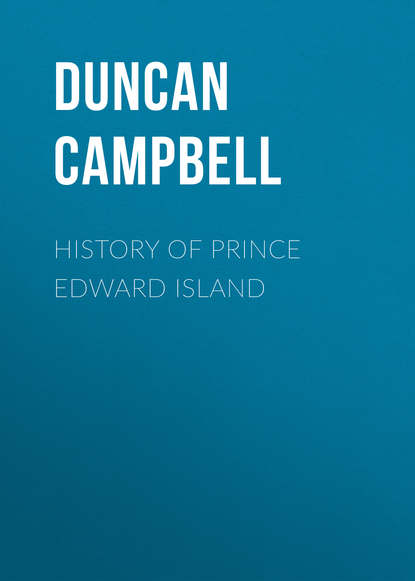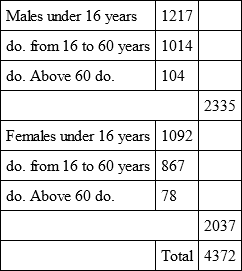 Полная версия
Полная версияПолная версия:
History of Prince Edward Island

Mr. Stronach manages the mechanical department efficiently, and the amount paid annually in wages is such as confers signal benefit on Charlottetown.
One word about Charlottetown. If the city were to represent the intelligence and enterprise of the fair and fertile isle of which it is the capital, it would be celebrated in the Dominion for the excellence of its sidewalks, its copious supply of water, its thorough system of drainage, and the delightful salubrity of its atmosphere. Since our arrival on the island, our head has been more than once in danger of coming into violent contact with the dilapidated wooden structure beneath. “I smell you in the dark,” said Johnson to Boswell, as they walked on one of the then unwatered and undrained streets of Edinburgh, and certainly, the redolence of Charlottetown can hardly with truth be said to be elysian. The return of Mr. William Murphy, the representative of pure water, to a civic seat, from which he ought never to have been ejected, augurs that the legislative and municipal steps already taken to furnish a remedy for evils which can no longer exist without injury to the health of the inhabitants, will lead to a speedy consummation devoutly to be wished; and then Charlottetown will stand, in the estimation of tourists, in the position which its natural advantages warrant.
In hotel accommodation, the extensive and well-equipped Island Park Hotel of Mr. Holman, which we visited, is a credit to the island. The hotel of Mr. John Newson, at Rustico, is also well reported; and we are given to understand that Miss Rankin, determined that Charlottetown should no longer lag behind the times, is about to have a handsome house erected in a most suitable locality. A few first-class hotels will not only be mutually profitable to the owners, but also beneficial to respectable houses of all grades.
A Return of the Inhabitants on the Island of Saint John, taken in April, 1798, by order of His Excellency Governor Fanning, &c., &c., &c.: By Robert Fox, Deputy Surveyor.11

Total Number of Inhabitants: —

1
The Rev. Mr. Sutherland, in his Geography, estimates the population at about four thousand, which corresponds with the estimate of the writer. See History of Nova Scotia, page 143.
2
The writer has obtained his information from manuscript copies of the original minutes of the Commissioners of Trade and Plantations.
3
The method of granting the lots was the following: – The Board of Trade ordered all petitioners for grants to appear before them personally or by deputy on the 17th and 24th June, and 1st July, 1767, in support of their respective claims. During these days, after hearing parties, they selected those whose claims seemed preferable, and on the 8th of July the list was completed, and finally adopted. The balloting took place on the 23rd of July, 1707, in presence of the Board. The name of each applicant was written on a slip of paper or ticket, and put in the balloting box, – the lots being granted in running numbers as they were drawn.
4
See manuscript minute of meeting of Commissioners of Trade and Plantations, dated eighth July, 1767.
5
This gentleman was not John Stewart, of Mount Stewart. The latter was only twenty-three years of age when John Stuart was appointed by the assembly their agent in London, and he had been only three years on the island at the time of the appointment. His Honor Sir Robert Hodgson, the Lieutenant Governor, has taken the trouble to peruse the correspondence which passed between Governor Patterson and John Stuart, and in a note addressed to the writer, says: “I feel convinced that John Stuart was the person whose name appears on the Island Statute of 30 George III, cap. 5, of the year 1790, as the owner of ten thousand acres of land; and who, I have always understood, was a personal friend of Governor Patterson, and if not an original grantee, must have acquired his land by the instrumentality of his friend the governor, under the sale of the lands for the non-payment of quitrents, so frequently alluded to in the correspondence.” The writer has carefully gone over the list of original grantees, in which there is one named John Stewart, but not one who spelt his name Stuart.
6
The following is a copy of the despatch addressed to Fanning: —
“Whitehall, 5th April, 1787.
“Sir, – Your despatch, number one, of the fourteenth of October last, in answer to my letter of the thirtieth of June last, was duly received, and I have since been favored with your letters, numbered two, three, and four, giving an account of your arrival in the Island of Saint John, and of certain proceedings which have taken place subsequent to that time.
“His Majesty, from the very extraordinary conduct of Lieutenant-Governor Patterson, has thought it advisable to dismiss him at once from office, and has been graciously pleased to fix you in the government of that island, persuaded, from the proofs you have given of your zeal for his service, as well as of your prudence and discretion, that you will make a suitable return for the confidence which has been placed in you by a faithful and diligent discharge of your duty.
“I am, sir, your obedient servant,
“Sydney.
“To lieutenant-governor Fanning.”
The following is the letter of Lord Sydney, formally intimating to Patterson his dismissal, as well as the reply to the communication of Patterson to his lordship, already given: —
“Whitehall, 5th April, 1787.
“Sir, – I have received your letter, number thirty-one, of the fifth November last, in answer to one from me of the thirtieth of June preceding, wherein you have stated certain reasons which have induced you to delay the carrying into execution His Majesty’s commands, which were sent to you by me, for delivering over the charge of the Island of Saint John to Colonel Fanning, and for your returning to England to answer certain complaints which have been exhibited against you.
“Without, however, entering into the grounds upon which you have proceeded to justify disobedience of His Majesty’s orders, I must acquaint you that I have received his royal commands to inform you that His Majesty has no further occasion for your services as Lieutenant-Governor of Saint John.
“Colonel Fanning, who has been appointed your successor, will receive from you all the public documents in your custody, and such orders and instructions as have been transmitted to you which have not been fully executed.
“I am, sir, your obedient, humble servant,
“Sydney.
“Lieutenant-Governor Patterson.”
7
In Dr. Patterson’s memoir of the late Rev. Dr. James Macgregor, there is an interesting reference to an interview which the latter eminent missionary had with Mr. DesBrisay. “I afterwards,” wrote Dr. Macgregor, “became acquainted with him, and was always welcome to preach in his church, which I uniformly did when I could make it convenient. His kindness ended not but with his life.” Dr. Macgregor states incidentally that at this period Charlottetown was a wicked place. We may safely affirm that it was not more wicked than any other seaport of its population.
8
The Honorable Mr. Brecken and the Honorable Mr. Davies were favorable to union, on what they conceived equitable principles, but opposed to what was termed the Quebec Scheme.
9
The author is indebted for this graphic sketch to the kindness of Mr. John T. Mellish, M. A., who was personally acquainted with Mr. McDonald.
10
The island having entered the confederation with the Dominion on the first July, 1873, Canadian manufactured goods since then have not come under the head of “imports,” which explains the apparent decrease. The same remark applies to exports, because all island products sent to Nova Scotia, New Brunswick, Magdalen Islands, and Canada, which were formerly “exports,” are not so reckoned now. In the value of exports is included the price of the tonnage sold or transferred to other parts.
11
The orthography of this list is strictly according to the original document.



